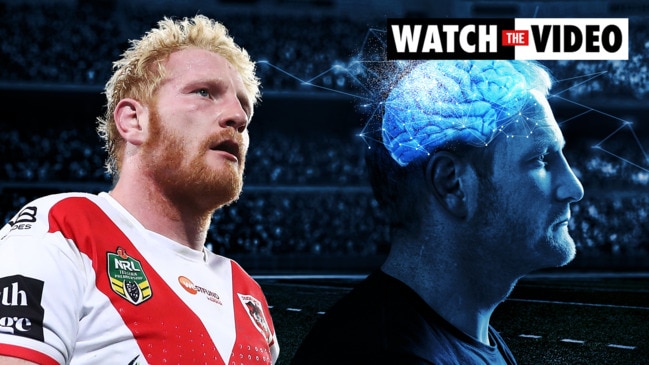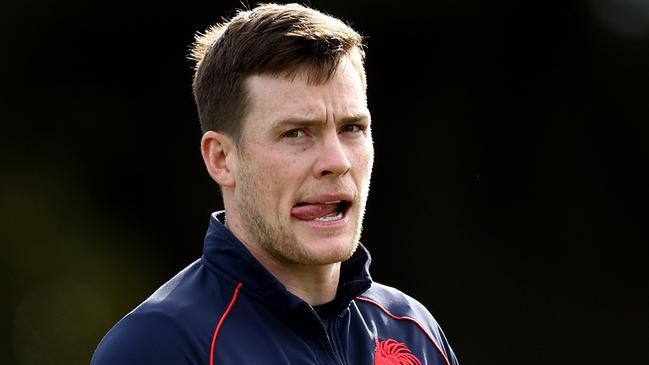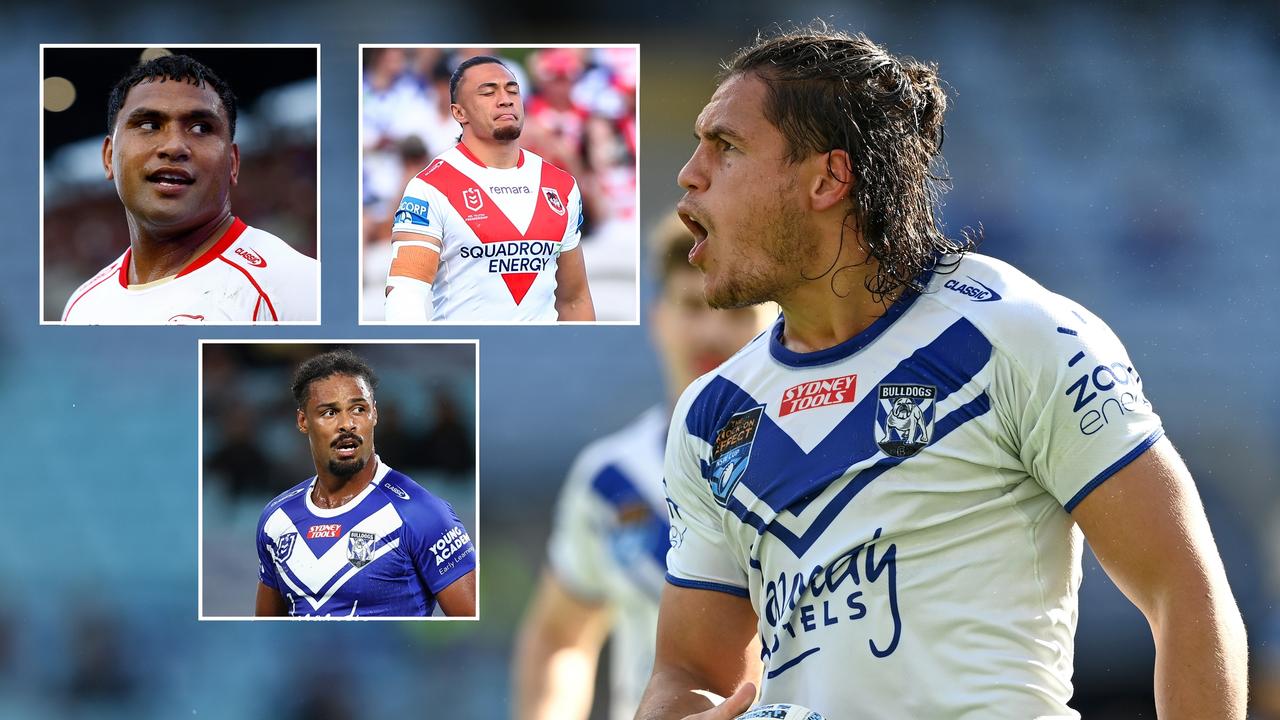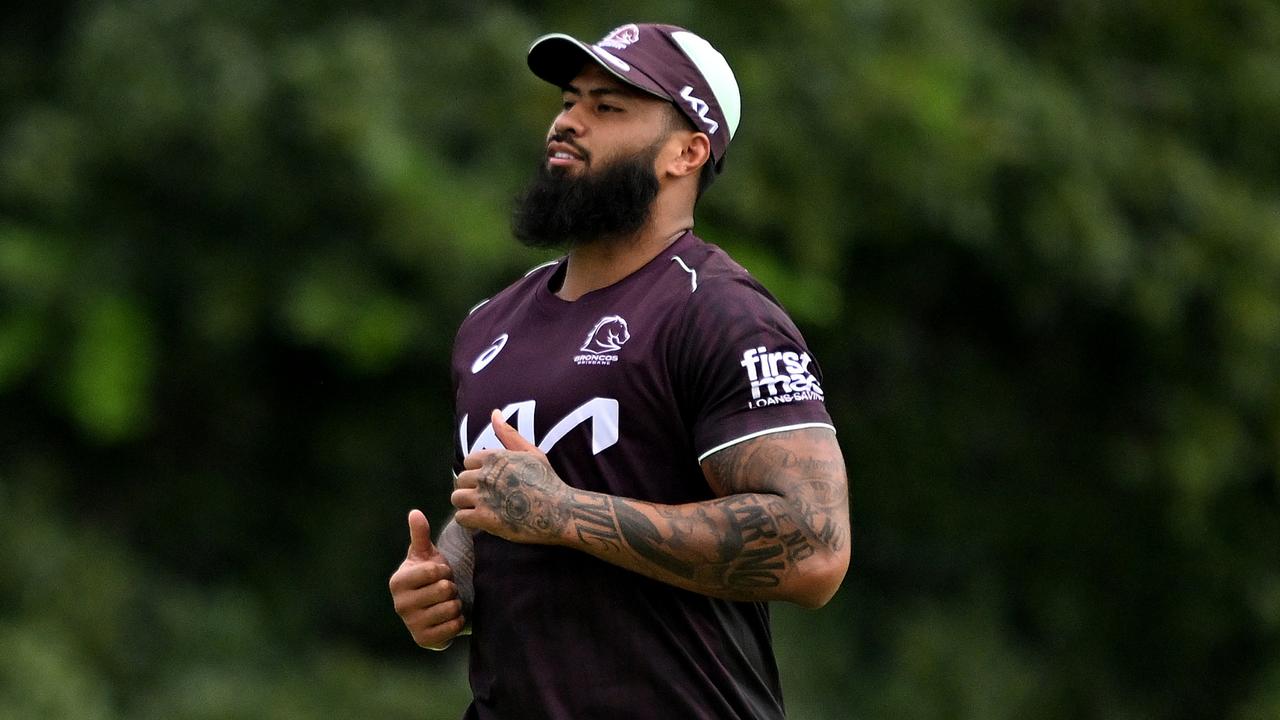Paul Kent NRL column: Concussion concerns for sport’s future as clubs manipulate HIA rule
Clubs manipulating HIA rules has fast become the NRL’s worst-kept secret, writes Paul Kent — and it could have dire consequences for the sport’s future.

NRL
Don't miss out on the headlines from NRL. Followed categories will be added to My News.
It comes as a particular irony to us unfettered types that every time we start talking concussion in rugby league we suffer a little throbbing around the temporal lobes.
It is the brain going out in sympathy for a problem, perhaps, that can’t be solved.
No doubt part of it lies in the guilt from the hangover of when rugby league prided itself on its ability to hit the deck once or twice and climb to its feet again, either in the courtrooms or on the paddock — it didn’t seem to matter — stumbling wildly before heading back into the fray.
It was a quality the game still looks back on proudly. Playing through concussion carried a rare kind of honour, it must be said.
Many of the game’s greatest players would happily take you through some of the greatest games they ever played for us, if only they could recall them. Now, those days have instead been consigned to the days of white laces and shoulder pads.
It is in the news again this weekend, sparking a little throbbing, with late confirmation two of the game’s great warriors, Victor Radley and Cameron Murray, have been named and will play when the Roosters and Rabbitohs meet at Allianz Stadium on Sunday.

Aside from the possibility of Taylan May scoring the matchwinner for Penrith on Friday night it was the biggest potential headache inside headquarters this entire weekend.
Murray was knocked out a week ago in the first set of the game, falling backwards and trying to rise before faceplanting back to the ground again.
Radley went down somewhat more violently a week earlier, convulsing on the ground and frothing from the mouth before eventually getting stretchered off. The NRL later asked for no replays of the incident to be shown.
Both men have been linked since their schoolboy days.
They grew up playing against each other and often competing for the same spot in representative teams. Even now it continues.
Such was the ferocity of their concussions, few around the game believed they would play on Sunday if it was a normal competition game rather than an elimination final.
More than a few old fight trainers poked their heads out of the boxing gyms to ask how they could play, strictly from an observer’s point of view, clearly.
In their defence both clubs quite rightly pointed out both players have passed all their concussion protocols ahead of Sunday’s game, are free of symptoms, and are raring to go.
Say that for the indomitable spirit of youth.


The question nobody can answer, though, is are the protocols enough?
If the tests are far more stringent now than 10 years ago, what will they look like in 10 years time with new information?
More and more is being learned about concussion and its evil offshoot, chronic traumatic encephalopathy (CTE).
Earlier this week former NRL hardman James Graham launched a podcast, Head Noise, into concussions and Wednesday was a guest speaker for a Concussion Legacy Foundation lunch in Sydney (see story below).
Graham was one of the original protesters against the NRL’s concussion protocols.
“It’s my body,” he said. “I should have the right to decide.”
Graham has since changed his stance but remains firm in declaring it’s not for him to tell others what they should do yet, earlier this week, he said on NRL360 that the greatest change must come from the coaches.
It is an opinion held strongly here, also.

It is not quite an open secret in the NRL that clubs cynically manipulate head injury assessments (HIA) whether through faking a suspected concussion for a free interchange, faking a test to stop play and allow a defensive rest or, worst of all, pretending not to notice a clearly concussed player vital to their team’s chances.
The bunker doctor seems to have disappeared more and more the longer the season has gone on.
This is not entirely on the coach, but in the politics of club and game he is the only one who can effect true change.
While there is no firm evidence it would appear, anecdotally, there are more concussions now than ever before in the game. The counter argument is we’re simply far more conscious about identifying them.
Changing tackling styles, with more emphasis on collision, bigger bodies, and fitter athletes able to maintain their energy for the entire game, beyond the old 10-minute “softening up” period, all contribute.
One of the best ways to beat the wrestle in today’s game, for instance, is with late footwork at the line. Basically, late footwork before impact allows the ballrunner to get into the tackler’s shoulder instead of his sternum, where he is setting up to control the ballrunner through the tackle process.

This late footwork, though, is often why the tackler is concussed as often as the ballrunner nowadays.
The game-changer will come when CTE is able to be detected among those still living and breathing, or giving reasonable facsimiles thereof.
As most know, right now CTE is able to be detected only in cadavers, which seems like a grisly kind of business.
What happens if CTE is discovered in a living breathing teenager? What legal ramifications would it raise, a child below age discovered with long-term brain injury?
Before Wednesday’s Foundation lunch Harvard expert Chris Nowinski warned that Australia was well behind the rest of the world in preventing brain injury in children, saying tackle football should be banned before the age of 14.
This is a grim outlook.
Nowinski was an early pioneer in brain injury, among the first to challenge the NFL’s league of denial, which defended its research much like the tobacco industry defended itself against lung cancer claims.

The world is moving slowly, partly because the science is still new and still so inexact.
The other game-changer will come when doctors can simply prick a finger for a spot of blood and the sample will pick up biomarkers indicating symptoms of concussion.
That is where the science is heading.
Perhaps the only answer is that at some point the game will need to recognise that, like boxing and mixed martial arts, the inherent risk can’t be defeated and must be accepted in its elite form.
For rugby league it would mean two versions of the game, a pathway towards the elite NRL version, with a full understanding of potential consequences, and a safer participation version with concussion protocols heavily policed.
The bravery of young men like Radley and Murray elevates the game and, for all the science and grim futures, there is not a doubt which version they would choose.
Some good men can’t be kept down.
Change Keary wants forced on NRL coaches
- Fatima Kdouh
Sydney Roosters star Luke Keary believes the NRL is lagging in its responsibility to protect players from the repercussions of repeated collisions and must introduce a game-wide training mandate.
As it stands, the number of contact sessions and their duration, are up to the discretion of individual coaches. That NFL started limiting contact training to just one session per week in the regular season in 2011.
Keary, who has had a serious history with concussion, said the NRL needed to have introduced similar protocols five years ago.
“We should have had less contact five years ago … I don’t know why it has taken this long,” Keary said. “They do it in the NFL. I don’t know how we haven’t done those studies and tests … I just don’t know how it hasn’t happened.
“I speak to some of these docs and it’s the repeated hit you get at training. The constant whiplash … things like that. For that not to be controlled, it’s just weird.

“But obviously they are doing some stuff now, it will get to that, everyone knows it will get to that which it should.”
Keary believes the protocols should be introduced to protect teenage players like his own teammates Joseph Suaalii and Sam Walker.
“We need to protect the kids that come in at 18, who are tackling everyday at training in the pre-season and things like that,” Keary said.
I know the NFL they wear the padding over the helmets, hopefully we can do the mouth guards with the tracking.”
Numerous studies have now connected CTE, a degenerative brain disease, to repetitive brain trauma.
Keary said coaches are now taking the impact of repeated collisions into account when designing training programs but the NRL needed to introduce a set of uniform protocols.
“The coaches are good now. They understand too, they are not bashing you all the time,” Keary said.
“But there needs to be some parameters around it, so every coach and every team has to abide by those rules on a weekly basis.

As for what a contact session should look like in the NRL, Keary said he would accept any changes recommended, including longer stand down periods, by the governing body, who are currently undertaking a study in conjunction with the University of Newcastle.
“That’s for the experts, whatever studies they do, they have to make a recommendation to say …. I think the NFL has one pad session a week where they can have contact and it’s for a certain amount of time to restrict the chances of player getting (a head injury).
“I don’t know what that looks like for our game, you need to be battle hardened too, to be able to cop hits and things like that … there has got to be a middle.”
NRL CEO Andrew Abdo told The Daily Telegraph reduced contact at training and mandatory stand-down periods are being considered.
“We are in the process of reviewing policies and standards for training sessions and consulting medical experts and relevant stakeholders in this regard. The Commission will consider this work in due course,” Abdo said.

The Roosters five-eighth suffered five concussions in the space of 14 months between January 2018 and May 2019.
He missed five weeks this season after copping a head knock against Melbourne in round 14.
That setback raised questions about the immediate playing future of the three-time premiership winner.
But Keary said a premature retirement was never on the cards. Keary admitted he would willingly hang up his boots if neurological specialists warned another concussion would be detrimental to his brain health.
“I also have a good relationship with three or four top neurologists in Australia. I will listen to them before I start listening to people … but I know the club and the doctors would never put me at risk,” Keary said.
“So if they did think, ‘mate copping another hit (then it’s over)’, they would tell me straight away. I like to think I am smart enough not to just keep banging my head against the wall.”
Fitzsimons reignites feud with James Graham
- Jessica Halloran
NRL great James Graham has been left “astonished” by columnist Peter FitzSimons’s decision to use an event to support athletes and families suffering the aftershocks of concussion to instead repeatedly challenge the ex-St George player over his evolving views.
The launch event for the Australian arm of the Concussion Legacy Foundation – which supports players who suffer the impact of head blows around the world – was supposed to amplify awareness of the effects of concussion as Graham is exploring in Head Noise, his podcast with The Australian.
Instead, FitzSimons used a wider panel discussion on concussion to revive his past feud with the NRL great over head blows in rugby league, and repeatedly questioned Graham’s “role model” status to young rugby league players and his past stance on players continuing to compete despite being injured.

FitzSimons pressed Graham on his statement that “maybe for me, the meaning of life was finding something worth dying for. Was that rugby league?”.
A shocked Graham told The Australian he was stunned the Concussion Legacy Panel discussion became a debate that focused solely on “me and him”.
“I am astonished he attempted to make it about me and him,” said Graham, who is hosting The Australian’s chart-topping podcast investigation Head Noise. “I was hoping to talk about the Concussion Legacy Foundation being launched in Australia; however, Peter wanted to dig up the past. I am in shock.”
In a 30-minute discussion, moderated by CLF chief Chris Nowinski visiting from the US, FitzSimons relentlessly questioned Graham’s concussion views. “May I ask a question … I think it was on NRL360, you said something like, well look, to not show weakness to the opposition, just to make it look like I didn’t care, and you also said, really strong comments and Benji Marshall was shocked and you said ‘look, I have to find a purpose in life and maybe to find something worth dying for.”

“You said that you prioritised the present over the future the idea that you went super hard at football now, even if that was going to damage the future. Do you stand by those remarks now?”
Graham replied: “I am not going to betray my former self. That’s who I was.”
FitzSimons kept pushing Graham on his previous statements on concussion, whether if he had his time over he would conduct his football career differently and his role-model status with young footballers.
“But knowing what you know now, that you didn’t know at 22, you’re a wise head, you’re a veteran, you are respected, if you did have a chance to talk to a 22-year-old, and knowing he would listen?” FitzSimons said.
Graham interrupted: “That’s it, that’s my point, he wouldn’t. I know who I was, I know myself, very well.”
FitzSimons said: “As a thought experiment, say he did listen to you. If I was a 22-year-old league player and James Graham took me aside, of course I would listen. The question is, respectfully, knowing what you know now, and in a thought experiment the 22-year-old is going to listen. Would you say, ‘pull back if you get hurt?’ Don’t pretend you’re not hurt? Put your hand up and get off the field immediately”.

Graham replied: “Peter what you are asking for is a simple answer to what is a complex question.” While the pair shook hands and embraced afterwards, the tension in the room was at times palpable. Graham said he was hoping for a proactive debate on the issue.
In 2019, FitzSimons and Graham first came to loggerheads after the then-St George footballer’s statement that said he was prepared to accept the risk of head knocks to play the game he loved.
“The consequences of that are sometimes you get hit on the head,” Graham said in 2019. “You’ve got to go and play Oztag if you don’t fancy playing league any more.” FitzSimons took exception and penned a column labelling Graham’s thoughts “outrageous” and that they downplayed the seriousness of concussion.
“Time and again … I’d see you knocked motherless and still stay on,” FitzSimons wrote. “One time, you outright refused to leave the field, when a trainer told you the coach wanted you off, yes?
“That kind of resilience and will to win is one thing. But your comments downgrading the whole importance of the concussion issue are another. Hence why I write now. Champion, you just don’t get it. Not the first clue.”
Graham was moved to release a statement via his then-club the St George Dragons. “I’m actually appalled by you paraphrasing my words ‘basically, getting smashed in the head and getting on with it anyway is what goes with football’,” Graham wrote.
“Sorry NO! I didn’t say that, mate. Complete fiction. If you think I said that, maybe you are the one that needs assessing.”
In the lengthy statement, Graham accused FitzSimons of being “condescending” and claimed his article had “glaring errors”.

Graham said he took “neurodegeneration and long-term brain diseases incredibly seriously.”
In the time since FitzSimons has repeatedly called for some of the NRL’s most prolific footballers to retire.
In 2020, he wrote an opinion piece calling for Roosters captain Boyd Cordner, who had suffered a spate of concussions, to quit.
The headline read: “To hell with finals, retirement should be the next stop for Cordner”. He recently called for Roosters star Luke Keary to pull the pin after yet another head knock.
Nowinski, a former gridiron footballer turned WWE wrestler who suffered numerous concussions during his career, has become an advocate for athletes and their families. On Wednesday night, he launched the Australian chapter of the Concussion Legacy foundation in Sydney. He also unveiled the global campaign “Stop Hitting Kids In The Head”.
Nowinski said medical evidence showed there should be no tackling in junior sport before the age of 14. Nowinski showed an advertisement for the campaign showing kids wearing gridiron gear and smoking.
“We have to stop dressing up this dangerous activity as fun and games,” Nowinski said. “Kids tackling are going to get hit in the head … and those hits add up.”
He said the goal was to “eliminate repetitive head impacts by 2026” in soccer, American football, Australian football and rugby.
The CLF Australia has been launched in partnership with the Dr Michael Buckland-led Australian Sports Brain Bank.
Stream every game of every round of the 2022 NRL Telstra Premiership Season Live & Ad-Break Free During Play on Kayo. New to Kayo? Start your free trial now >
More Coverage
Originally published as Paul Kent NRL column: Concussion concerns for sport’s future as clubs manipulate HIA rule





